An encounter in Northern India
by Anthony B. Wooldridge
The latest on the Yeti tracks discovered in Nepal October, 2008 is HERE
Introduction
In early March, 1986, the author observed and photographed a large hominid-like
animal which was believed to be the Yeti. This remarkable incident occurred
by chance during a solo run in the Garhwal Himalaya of northern India,
near western Nepal.
My purpose in undertaking the run was to raise money
for an organization, Traidcraft, which supports self help projects in
developing countries. The run allowed me to combine my interests in long-distance
running and mountaineering, and to obtain first-hand knowledge of the
way of life in Himalayan mountain villages.
I have no special training
in zoology, and, when I undertook the run, I knew very little about the
Yeti. My conviction that the creature in question was a Yeti is based
on a subsequent detailed study of other reports, and on discussions with
experts on this topic.
Narrative Description
Between March 2 and March 10, 1986, I completed a solo run in the upper Alaknanda Valley (Fig. 1). Although I carried an ice ax and full survival equipment in my 8 kg rucksack, my strategy was to use accommodation available in the main villages, and hence avoid the need to bivouac. Both Hindu and Sikh pilgrims visit the area in the summer, although in early March any villages higher than about 2,000 meters are locked up and deserted.
On March 5, I left Joshimath early, ran easily up the valley as far as Govind Ghat, and then turned off up the Bhiundar Valley. That afternoon I reached an altitude of about 3,000 meters, and found the bungalows at Gangaria locked up and deserted. There were boot-marks in the snow as far as the bungalows, but they continued no further. I cached my ice ax and survival bag in the snow, and set off back to the Sikh gurudwara at Govind Ghat for the night. My plan was to stock up with food, get a good night's sleep, and return as early as possible the next morning to reach Hemkund while the snow was in reasonable condition. By the time I reached Govind Ghat, I had covered 50 km, with about 1,860 meters of ascent since the morning.
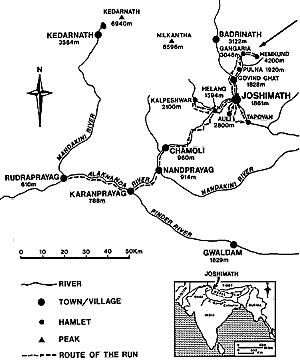 |
Fig. 1. - Routes followed by the author in the Himalayas indicated by arrows. Long arrow in upper right indicates location of the sighting of the presumed Yeti. The area is near the border with western Nepal. |
On March 6, I left the Sikh gurudwara just after 6 a.m., and, although they had told me that the route to Hemkund was impassable because of ice I was determined to see for myself. At Pulna, the last inhabited village (1,920 meters), I inquired about a local guide willing to go up to Hemkund, but could find no one willing to risk the possibility of icy conditions and a chilly bivouac. Their reticence did not inspire confidence in my chances of reaching Hemkund alone, but at least I could travel more rapidly unaccompanied, and was prepared to spend a night out if it proved necessary.
I ran most of the way up the valley until I reached the snow at about 2,800 meters, and then the huts at Gangaria (3,048 meters) by 10 a.m. Beyond Gangaria, I could just discern the track leading off up toward Hemkund, but there were no signs of anyone else having used the route since the last snowfall, and probably since the previous autumn. There had only been a light frost overnight, and with the sun thawing the thin surface crust of snow, I was soon sinking in above the tops of my training shoes.
As the track followed steep wooded slopes beyond Gangaria (Fig. 2), I was surprised, around 3,300 meters altitude, to come across an area where the snow had recently been disturbed. Strange tracks came up a steep gully on the right, and then went from bush to bush in the wood. I was naturally curious to know what creature could be sharing the wood with me, but could think of no satisfactory explanation. I took two quick photographs of the tracks (Figs. 3 and 4), and pressed on, knowing that time was precious if I was to reach Hemkund before the snow became too soft. Perhaps half an hour later, as I was emerging above the tree line, there was a sudden "bang," followed by protracted rumbling, and although I could not see any signs of snow movement, my first reaction was to suspect an avalanche.
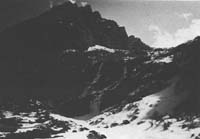 |
Fig. 2. - The terrain beyond Gangaria, toward Hemkund. |
By 12:30 p.m., I had reached about 3,800 meters, where my route left the comparative shelter of the cliffs and continued across an exposed steep snow slope. I became increasingly concerned about the stability of the snow, and was soon dismayed and worried to see that a recent wet snow avalanche extended right across my intended route. I continued for a few hundred yards to get to a better position to survey the damage and to assess the risks of proceeding. While studying the track of the debris, I noticed a large, smooth groove in the loose snow which might have been caused by a large rock sliding down. But the groove came to an abrupt end just at the point where a set of tracks led off across the slope behind and beyond a spindly shrub. Standing behind the shrub was a large, erect shape perhaps up to 2 meters tall. Convinced that, whatever it was, it would disappear quickly, I took several photos rapidly, and then moved up about 50 meters nearer to a rocky outcrop, which was as close as I could get without venturing onto the broad, open snow slope which had just avalanched.
It was difficult to restrain my excitement as I came to the realization that the only animal I could think of which remotely resembled this one before me was the Yeti. My skepticism about the creature's existence was overturned by this all-too-real creature then in view. It was standing with its legs apart, apparently looking down the slope, with its right shoulder turned towards me. The head was large and squarish, and the whole body appeared to be covered with dark hair, although the upper arm was a slightly lighter color. The creature was amazingly good at remaining motionless, although the bush vibrated once or twice, and when I moved back down to lower ground, it appeared to have changed its head position and to be looking more directly at me.
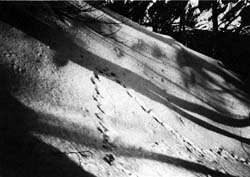 |
Fig. 3. - Unidentified tracks in snow at 3,300 meters observed by author. |
I took a number of photographs from an estimated range of 150 meters, one of which is included in the report (Fig. 5). At the time, I was unaware that no one had ever actually photographed a Yeti before, but I was aware that the pictures would be of great interest-provided that I got back safely. Unfortunately, my camera was only a light, compact 35 mm model, with a slightly wide angle lens. Being a Nikon, however, the lens is of good quality, so that the negatives have withstood considerable enlargement (Fig. 6). The sketch (Fig. 7) is included to clarify the general stance of the creature for those not having access to the original photographs. Some of the detail in this sketch should be regarded as conjectural. For example, with the creature seen in silhouette, it was not possible to distinguish any facial features, or to be certain of the depth to which its legs were submerged in the snow.
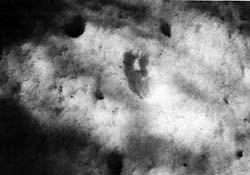 |
Fig. 4. — A single footprint. Its length was about 250 mm (10 in). |
After about 45 minutes, the weather continued to deteriorate, and light snow began to fall. The animal still showed no sign of moving, although occasionally the shrub vibrated slightly. I moved back down the slope a short distance, and got the impression that the animal was now peering towards me around the other side of the shrub, but its feet had not changed in position. It was now about 1:30 p.m., and with the weather clouding over fast, I felt it was time to descend before new snow obliterated my tracks. On the way down, I kept a keen lookout for any further tracks, and noticed a considerable number on the slopes between the avalanche debris and the place where I had earlier seen the footprints in the wood. I surmised that the animal had been looking for food in the wood, and then on the open slopes above the trees. Perhaps it had been disturbed by my arrival in the valley, had made off over-hastily towards Hemkund, and had triggered off the avalanche.
Back in the wood, I came across the footprints which I had photographed some 3 hours earlier, but they had already melted severely in the intervening time. I photographed them as best I could, remembering to include my ice ax for a scale. The sky was now completely overcast, and the snow looked set to last some time, so I was reluctant to bivouac at Gangaria. I was torn between a strong desire to stay in the Bhiundar Valley for another day, and the need to maintain the schedule of my sponsored run. Since the Yeti was very likely to move over the col towards Hemkund that afternoon, and the footprints would be obscured by the recent snow, it was very doubtful whether much new evidence could be gleaned the following day.
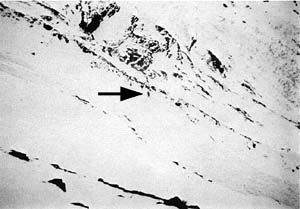 |
Fig. 5. - View across the avalanche debris. Arrow indicates figure presumed to be a Yeti. |
By 4:30 p.m., I was back down to Pulna, and I reached the main road to Joshimath by 5 p.m. Not stopping as I passed the man brewing tea in the hut near the road, I made record time toward Vishnu Prayag, covering the 9 km in 40 minutes. It was dark by the time I finished the climb up to Joshimath, and I staggered in to the Tourist Resthouse to find the manager sitting in his usual chair near the entrance. He was rather amazed about the distance I had traveled that day, and particularly that I had ventured towards Hemkund without a guide. I had covered a distance of about 58 km and ascended a total of nearly 3,000 meters. I would have enjoyed giving him a full account of my experiences that day, but I had already decided that, rather than risk a hunt being set up for the animal, I would keep the news to myself until the proper authorities in India and elsewhere had been consulted.
Results
Returning to England on March 15, my spare time was spent reporting on the sponsored run, while consulting in comparative secrecy with zoologists, anthropologists, and mountaineers about the Yeti. The news of my encounter was first released on the BBC TV program "Wild Britain" on July 13, and more fully reported in BBC Wildlife magazine, September, 1986.
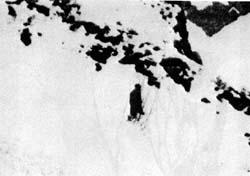 |
Fig. 6 - Enlargement of the figure appearing in Fig. 5. |
A number of experts believe that the creature I saw was probably a Yeti; others prefer to keep an open mind. John Napier, a primatologist and author of the 1973 book Bigfoot: The Yeti and Sasquatch in Myth and Reality, has reversed the skeptical position he had previously expressed, and now describes himself as a Yeti devotee. Myra Shackley, an archaeologist and author of the 1983 book Wildmen: Yeti, Sasquatch and the Neanderthal Enigma, has seen the full sequence of photographs, and believes that the whole experience is very consistent with other reports of Yeti sightings. Lord Hunt, leader of the successful 1953 Mount Everest Expedition, who has twice seen Yeti tracks himself, is similarly convinced.
Desmond Morris, who has produced a TV documentary about the Yeti, suggests three possible explanations for my sighting. The creature might have been a known mammal, such as a bear or large monkey, which had temporarily become bipedal, it might conceivably have been a human recluse (saddhu), or it may have been a real Yeti. He has some difficulty in accepting any of these alternatives, but regards the Yeti to be somewhat more plausible than the other explanations. Chris Bonington, the mountaineer, is of a similar opinion.
I have photographs of footprints (two taken on the ascent and a larger number on the descent), together with some 20 photographs of the creature itself, the latter taken from about 150 meters. Examples are shown in this Field Report (Figs. 5 and 6). Since the image of the creature on the 35 mm negatives is only about 1 mm high, considerable enlargement is needed to obtain a reasonable size picture.
More recently, UKAEA's Harwell Laboratory has carried out digital computer processing of several negatives to improve the fine detail, and an example is also shown here (Fig. 8). Although this processing was carried out in black and white, it has improved the contrast range so that the animal's arm stands out more clearly. There is, however, a limit to what can be achieved digitally, since the image is not blurred or out of focus, but, rather, the detail desired is comparable with the grain size of the emulsion. For this reason, more sophisticated computer routines, such as edge enhancement, are believed to have little to offer in refining the images.
Future Plans
The most significant additional information which I hope to obtain concerns measurement of the creature's size using photogrammetric techniques. This would require revisiting the area to obtain a theodolite survey of identifiable features of the terrain. It would then be possible to calculate the precise camera positions from which my photographs were taken, and to use pairs of negatives to measure the creature's dimensions to an accuracy of perhaps 5 percent.
Secondly, I am endeavoring to establish in what respects this experience is similar to — or differs from — other reports of Yeti footprints or sightings. Readers of Cryptozoology may well be able to help in this respect, and I have also contacted various people in India who are knowledgeable about the Garhwal.
The author wishes to thank S. F. Burch, of UKAEA's Harwell Laboratory, England, for carrying out the digital processing for Fig. 8. J. M. Coffey is thanked for the sketch appearing in Fig. 7. The help of S. Johnson in preparing the map in Fig. 1 is also gratefully acknowledged.
The author requested publication of the following Addendum, containing additional information, to which the Editor agreed.)
Addendum
Was It a Yeti? Some Personal Thoughts on the Encounter
(by Anthony B. Wooldridge)
Introduction
This note sets down my main reasons for concluding that the animal met in the vicinity of Hemkund on March 6, 1986, was probably a Yeti. Some of the points which have puzzled those who have heard about the incident are also discussed.
Why the animal was probably a Yeti
The most compelling evidence for the Yeti explanation is the similarity between other reports of footprints and sightings and the footprints and the general appearance of the animal which I observed. The single footprint of a left foot (Fig. 4) shows a large impression caused by the big toe, which is well separated from, but parallel with, the other toes. Behind it is a curious depression. These features are very reminiscent of Eric Shipton's photograph taken in 1951 on the Menlung Glacier, although the detail of the other toes is much clearer in the latter photograph than in mine.
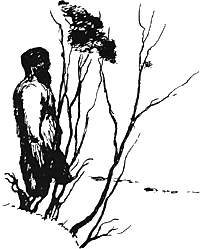 |
Fig. 7. - Artist's impression of the figure's stance. (J. M. Coffey.) |
As for the animal's general appearance, it is very much in line with the general consensus of a large animal capable of standing erect in an almost human posture, and with a powerful chest and long arms. What is particularly remarkable is the similarity with the creatures described by Slavomir Rawicz in his 1956 book The Long Walk. He mentioned specifically that the heads were squarish, and that, seen in profile, the back of the head was a straight line from the crown to the shoulders. This squareness was one of the features which I noticed immediately. Rawicz claimed to have observed the creatures for 2 hours in 1942, without once seeing them drop onto their hands, and he said that "their interest in the humans seemed to be of the slightest." This was also the impression that I gained, since the creature seemed more interested in looking down the avalanche than at me. Rawicz noted that the animal's shoulders sloped sharply down to a powerful chest. Most of the body was covered with a tight, close fur, but this was mingled with long, loose, straight hairs hanging downwards which had a light grayish tinge as the light caught them. Similar lightish hairs might be the explanation of the lighter band around the crown of the animal I observed, although, with the sun behind the animal, it was difficult to distinguish small color variations. Rawicz's narrative has been criticized for technical inaccuracies in parts, but his description of the creatures is so similar in points of detail to my own experience that it is difficult for me to dismiss.
Many accounts of the Yeti refer to a pointed head with a pronounced sagittal crest when seen from the front. I am not able to comment on this, as I observed the head from the side. As for the color of the hair or fur, it looked dark brown, with no evidence of the red tinge mentioned in previous accounts. However, with the sun behind the animal, it was not easy to distinguish small color variations. The Yeti is also reported to emit a shrill whistling sound, particularly when frightened. I have no recollection of any sounds which struck me as unusual during my ascent, although I was approached by a very large bird of prey — probably a Himalayan griffon vulture —and might have attributed any strange sounds to this bird. Once I reached the avalanche, the animal certainly did not emit any audible sounds.
Why it was unlikely to be a langur monkey, a bear, or a human
A number of other possible candidates for what I observed have been suggested — an unusually large langur monkey, a bear, or a man. I will consider each in turn.
The common langur (Presbytis entellus) is not known to exceed 20 kg in weight, has a long tail, makes narrow footprints (about 50 mm wide), with the big toe at right angles to the others, and it is unlikely to stand erect for 45 minutes. None of these characteristics is consistent with those of the animal I encountered. It is true that langur monkeys live in the general area, and I saw several colonies, each of perhaps 40 monkeys, lower down the Bhiundar Valley. However, I am certain that such relatively small, arboreal animals could not be confused with the large animal I saw near the avalanche.
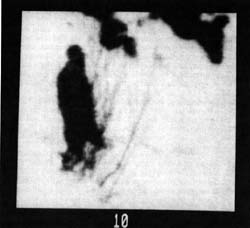 |
Fig. 8. - Digitally processed image of the figure. (Harwell Laboratory, UKAEA). |
A bear is broadly of the right size and weight, but the profile of the head and shoulders I saw was not bear-like, and there is no evidence of a projecting muzzle in the photos. It is also extremely unlikely that a bear could, or would, stand erect for such a long time, and with its front limbs hanging down in a most unbear-like manner. Neither the single footprint (which had not suffered from melting), nor the pattern of tracks near the bush (Fig. 3), can be easily explained as bear tracks.
The figure near the avalanche had some human-like physical characteristics, but it is difficult to imagine a recluse or saddhu (hermit) having clothes resembling fur, and with such a uniform close fit. The footprint in the wood is not human, nor is it consistent with a foot covered with bandages, and the tracks both in the wood and on the open slopes above go up steep, difficult terrain, and are more indicative of an agile animal than a human. Furthermore, it is difficult to imagine a human getting involved in an avalanche and then standing nearly motionless for about 45 minutes observing a fellow human.
Personally, I discount the idea of a langur monkey or bear, and consider the possibility of the figure being human to be a less plausible explanation than the proposition of an unknown hominoid or hominid — the Yeti.
Reasons for my own behavior
I have been asked repeatedly why I did not attempt to get closer to the animal, or try to attract its attention by shouting or throwing objects. My primary concern was the very real possibility of another avalanche. No one would have come looking for me had I suffered an accident, and I had got as close as I judged to be safe. I felt that the animal had good reasons for remaining stationary, whether to be less visible, to avoid triggering a second avalanche, or because it was injured. It must have been well aware of my presence, as a man with a bright red rucksack and blue hat on an open snowslope would be difficult to miss. Since my movements to take photographs over about 45 minutes had produced virtually no response, there is no certainty that shouting would have made the animal flee. Besides, I did not wish to frighten it into an over-hasty reaction, and there was always the faint possibility that it might have moved in my direction!
Naturally, it would have been a tremendous advantage to have had a telephoto lens, or even a pair of binoculars. However, I had needed to keep weight to a minimum for my 200-mile run. Had I sacrificed some survival gear in favor of a single-lens reflex camera with interchangeable lenses, I might not have ventured so far towards Hemkund on my own. Furthermore, carrying additional weight would have slowed the schedule of my whole run, and I might not then have had the good fortune to cross paths with the Yeti at all. Fortunately, my Nikon AF3S produced sharp, well-exposed photographs that have withstood substantial enlargement.
My main regret is that I only took two photographs of the tracks in the wood during the ascent, when they were fresh and sharp. If only I had taken more interest in the Yeti before beginning my run, I might have immediately realized the significance of the tracks. A detailed study of the pattern of the tracks might then have shed considerable light on the animal's methods of movement over varied terrain.
As for following up my sighting immediately by getting local people engaged
in a hunt, I still believe I made the right decision.
First, I had no
wish to do anything which might have endangered the animal's survival.
In this respect, I am not among those who support killing such creatures
in order to prove their existence and to classify them.
We have less destructive
ways of studying wildlife nowadays. Secondly, there would probably have
been little if any evidence the following day, with all the tracks melted
and obscured with the fresh snow, and the Yeti (hopefully) safely away
over the col into a remoter area.
Source: Cryptozoology, 5, 1986, 63-76.
(A subsequent trek revealed object was a rock formation, still standing
there...ending up being a classic case of misidentification...)
The latest on the Yeti tracks discovered in Nepal October, 2008 is HERE
Back
to Newspaper & Magazine Articles
Main
Portions of this website are reprinted under the Fair Use Doctrine of International Copyright Law as educational material without benefit of financial gain. This proviso is applicable throughout this entire website.